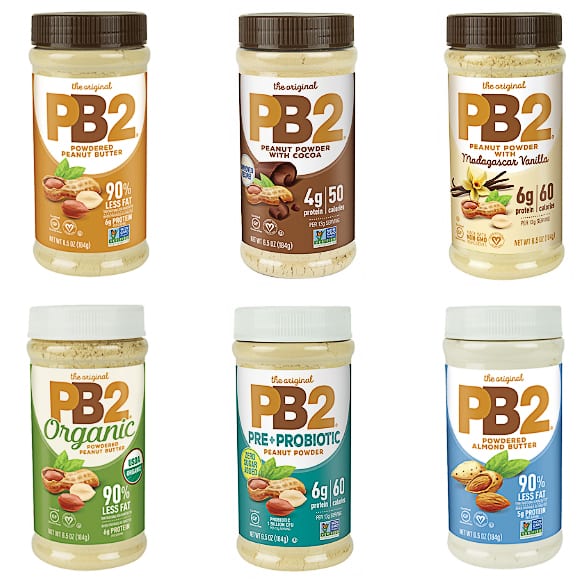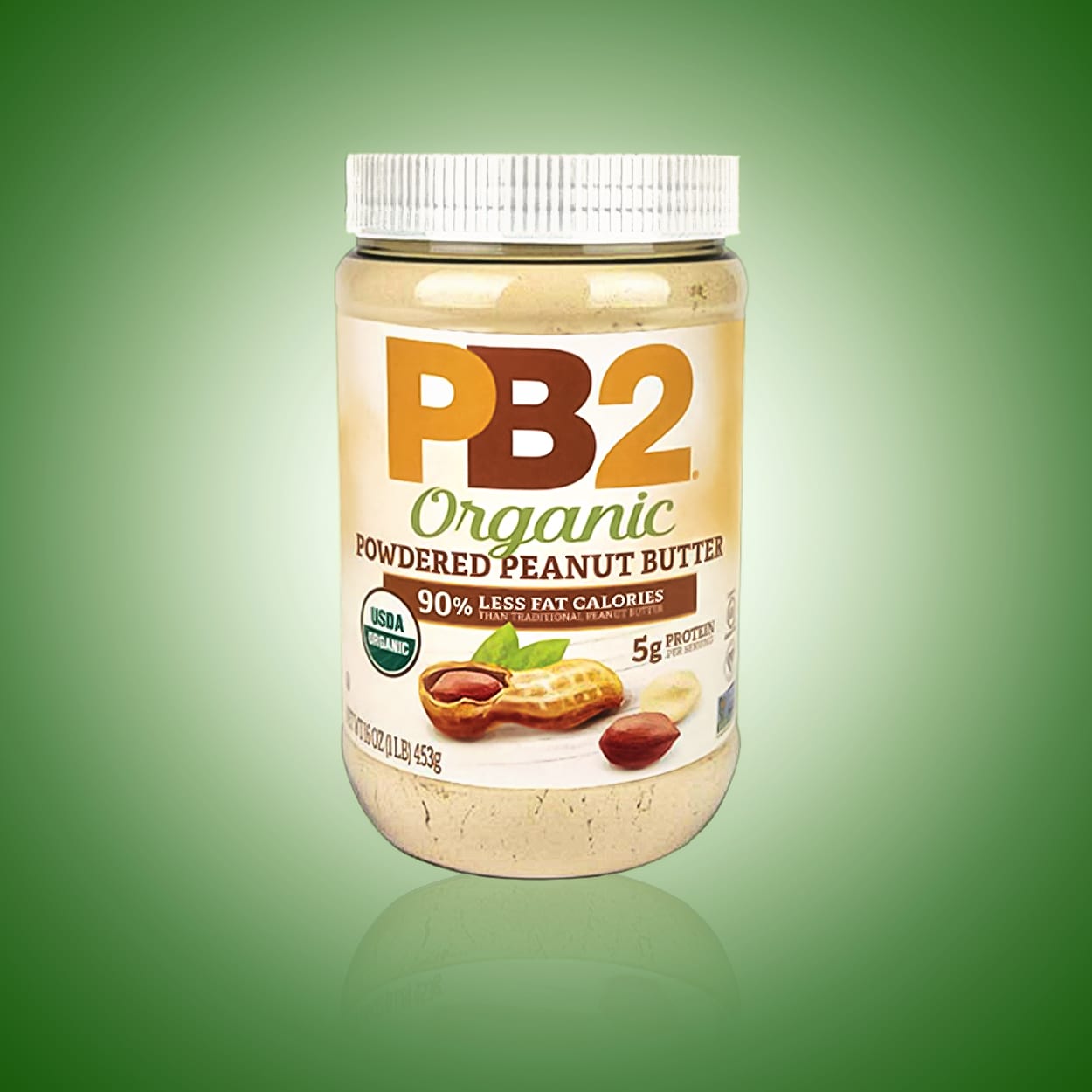Written by J.B. Shepard, professional pet photographer and founder of the Puptrait Studio.
If we know anything about dogs, it’s that most of our furry little friends absolutely LOVE peanut butter. It is essentially the perfect dog treat, loaded with all the things dog’s look for in a tasty snack — proteins, fats, sugar, salt, and other essential nutrients. So, it should come as no surprise to anyone why dogs go absolutely bonkers for peanut butter.
When considering the safety of pet foods and dog treats always ask your vet!
PLEASE NOTE THAT WE ARE A PROFESSIONAL PET PHOTOGRAPHY STUDIO AND ARE NOT VETERINARIANS. THIS POST IS NOT INTENDED AS MEDICAL ADVICE OR AS A SUBSTITUTE FOR ADVICE FROM A VETERINARY PROFESSIONAL. ALWAYS BE SKEPTICAL OF WHATEVER YOU READ ONLINE, ESPECIALLY WHEN IT COMES TO ANYTHING AS IMPORTANT AS THE HEALTH OF YOUR DOG. WHEN IN DOUBT ALWAYS ASK YOUR VET.
The original PB2 Peanut Butter Powder formula has only 3 simple ingredients — roasted peanuts, salt and sugar. In other words, all of the basic nutty goodness that dogs love, without any of the filler or chemicals we’ve come to expect from a lot of other off-the-shelf brands.
And yes, the original PB2 peanut butter powder is perfectly safe for most dogs.
In this article we will first explore some of the bigger red flags to keep an eye out for when shopping different peanut butter products for your dog and then will use that information to evaluate the current lineup of various PB2 nut butter formulas (spoiler: not all of them are safe for dogs).
Quick links for this article…
- Is peanut butter dangerous for dogs?
- Dangerous ingredients commonly found in peanut butter
- Is PB2 powdered peanut butter safe for dogs?
Is peanut butter dangerous for dogs?
Unless your dog has an allergy to peanuts, certain food sensitivities or is strictly managing its weight, most peanut butters are actually pretty healthy. But there are a few ingredients used in some peanut butter products that can pose a health risk to your dog.
Ingredients commonly found in peanut butter that are dangerous to dogs:
When evaluating whether a peanut butter is safe to give dogs we are primarily looking out for three types of ingredients – artificial sweeteners, cocoa, and grapes. That is by no means an exhaustive list of dangerous ingredients and additives to look out for, but these are by and large the most common dangers found in peanut butter marketed to humans. Not for nothing, one of the great things about PB2 powdered peanut butter is that most of their formulas are fairly simple and easy to read.
Xylitol (Sugar Alcohol)
Commonly found in:
Xylitol is commonly found in sugar-free, low calorie, or diet peanut butters and other nut butters (almond butter, sunflower butter, hazelnut spread, etc.). It can also be found in breath mints, cough syrup, mouth wash, tooth paste, chewing gum, dietary supplements, baked goods and sugar-free desserts.
What is Xylitol?
Xylitol is a class of sweetener known as sugar alcohol, which as you may have guessed from the name combines the properties of both sugar and alcohol. While most pet owners understand the obvious dangers of giving their dogs alcoholic beverages. Other common foods, beverages and household products that contain many of the same toxic properties and risks to dogs are often overlooked by many dog lovers simply because they’re not intended to be consumed for inebriation purposes.
The FDA has recently released guidance for dog owners warning about the risk of xylitol and other sugar alcohols. If you’ve been hearing a lot of buzz lately on social media about the dangers of peanut butters, there is a good chance this is why. In recent year, xylitol has become an increasingly popular sugar substitute (lauded by both diabetic and dental experts alike). And, while xylitol if overwhelming safe for most humans to consume it does pose a unique risk for dogs.
Why is Xylitol dangerous for dogs?
The blood sugar level of dogs (like humans) is controlled by the pancreas, which releases insulin into the blood stream. As xylitol does not stimulate the release of insulin in humans, the sugar substitute can be a great option for diabetics who struggle to manage their insulin and blood sugar levels. But this is not the case with dogs.
When dogs consume xylitol it can result in the pancreas releasing a sudden surge of insulin. Which wouldn’t be a problem if dogs could metabolize xylitol as sugar, but as they can’t this spike of insulin can results in the dog’s blood sugar to crash to unsafe levels (hypoglycemia). Untreated, this sudden drop in blood sugar can result in seizures and other life threatening conditions.
Symptoms of Xylitol poisoning in dogs
If you think your dog may have consumed xylitol, take them to the vet or an emergency animal hospital immediately. Please be advised that your dog may require hospitalization or medical monitoring, as some adverse effects may not occur for up to 24 hours.
Symptoms of concern include:
- sudden drop in blood sugar levels
- vomiting
- pacing
- decreased activity
- weakness
- staggering
- incoordination
- collapse
- seizures
Cocoa (Chocolate / Theobromine)
Commonly found in:
Cocoa is commonly found in chocolate flavored peanut butters and other cocoa flavored nut butters (almond butter, sunflower butter, hazelnut spread, Nutella, etc. ), as well as chocolate covered candies (peanut butter cups, buckeyes, M&M’s, etc.). While commonly known as “Chocolate poisoning”, overdosage reactions to the alkaloid theobromine can also be triggered by foods other than chocolate, including teas and cola beverages.
What is Cocoa?
When listed as an ingredient, the term “Cocoa” most commonly refers to a chocolate powder made from fermented, roasted and ground cacao (or cocoa) seeds, is typically added to recipes to add chocolate flavoring and coloring. It should be noted that cocoa is a fairly ambiguous term and may refer to a number of items derived from the fermented seeds of the Theobroma cacao plant and may even refer to the seeds themselves.
That all said, virtually all forms of cocoa and chocolate are dangerous for dogs and many other animals to consume. To the extent that mulch and compost composed from the shells of cacao plants have been attributed to the death of livestock and some wildlife, including bears.
Why is Cocoa and Chocolate dangerous for dogs?
Cocoa and tea contain the methylxanthines alkaloids theobromine and caffeine. While these compounds present minimal risk to humans, dogs process theobromine and caffeine much more slowly (in effect, the toxic effects can build in their system much more rapidly). This combined with the relatively diminutive size of dogs and their indiscriminating eating habits, means dogs are significantly more likely to overdose from consuming chocolate.
The LD50 (i.e. lethal dose) of combined methylxanthines found in cocoa is reportedly 100-200 mg/kg, but severe signs of toxicity and even death may occur at much lower dosages. Mild symptoms (vomiting and diarrhea) may present as little as 20mg/kg, cardiotoxic effects may be seen at 40 mg/kg, and seizures are likely to occur around 60 mg/kg. When you consider that the average dry cocoa powder contains roughly 800 mg of combined methylxanthines per ounce, these are some staggeringly small amounts.
In simpler terms, a 20 pound dog (~9 kg) is likely to vomit or have diarrhea after consuming as little as a quarter of a tablespoon of dry cocoa powder. A single tablespoon of dry cocoa powder is likely enough to induce seizures or even more severe symptoms.
What are Alkaloids?
Alkaloids are a class of nitrogenous compounds of plant, bacteria, fungi, or animal origin that have pronounced physiological actions on humans and other animals. Alkaloids can impact a wide range of different metabolic systems, but almost uniformly evoke a bitter taste. Caffeine, theobromine, nicotine, psilocin, ephedrine, morphine, quinine, atropine, mescaline, and strychnine are all common examples of alkaloids.
The term “alkaloids” is derived from the Latin root alkali, which in turn was derived from the Arabic word al-qalwi which means “ashes of plants”. This shared root has lead to somewhat widespread confusion in various internet forums and social media groups (often promoting various fad diets or other misguided health regiments), that alkaloids are somehow universally bad or inherently alkaline or base (measuring with a ph greater than 7.0 when dissolved in water). But in reality some alkaloids are actually neutral or weakly acidic.
And like most drugs, when administered correctly and in proper dosages, many alkaloids have found to be quite useful in both traditional and modern medicines providing a number of different functions — including analgesic, antimalarial, antiasthma, anticancer, vasodilatory, antibacterial and other medicinal purposes.
Symptoms of cocoa poisoning in dogs
According to the Merk Veterinary Manual, Chocolate toxicosis may result in potentially life-threatening cardiac arrhythmias and central nervous system (CNS) dysfunction. If you think your dog may have consumed chocolate or other foods that may contain theobromine, take them to the vet or an emergency animal hospital immediately. Please be advised that your dog may require hospitalization and medical monitoring.
Symptoms of concern include:
- vomiting
- diarrhea
- increased body temperature
- increased reflex response
- muscle rigidity
- weakness
- rapid breathing
- increased heart rate
- low blood pressure
- seizures
- cardiac failure
- coma
Grapes & Raisins (Jam / Jelly / Preserves)
Commonly found in:
Grapes and raisins can be found in any number of food items. But when shopping for peanut butters for your dog avoid premixed peanut butter and jam blends like (Smucker’s Goober, Great Value Stripes, etc.).
Why are grapes dangerous for dogs?
The ingestion of grapes and raisins can result in the development of anuric renal failure in some dogs. The exact mechanism behind the toxicity of grapes remains unknown and a clear dose-response relationship has yet to be determined, but as few as 4-5 grapes have been implicated in the death of an 18 pound dog.
It is also not understood why some dogs can consume grapes without issue and the condition has not been reproduced experimentally, though raisin extracts have been shown to damage canine kidney cells in vitro.
Symptoms of grape poisoning in dogs
Some dogs are perfectly fine eating large quantities of grapes. Most affected dogs develop symptoms within 6-12 hours of ingestion. Others spontaneously develop symptoms within 12 hours. If you think your dog may have consumed grapes and presents symptoms, take them to the vet or an emergency animal hospital immediately.
Symptoms of concern include:
- vomiting
- diarrhea
- lethargy
- anorexia
- adominal pain
- weakness
- dehydration
- polydipsia
- tremors (or shivering)
- renal failure (often fatal)

Is PB2 powdered peanut butter safe for dogs?
We have been huge PB2 peanut butter fans for years now. For those of you following our dog blog for awhile now, you may remember that PB2 is actually one of the primary ingredients of our signature stinky dog biscuit recipe.
There are two reasons we like making dog treats with PB2…
- Powdered peanut butters are easy to mix when baking.
- The simple ingredient list – roasted peanuts, sugar, and salt.
While PB2 remains as easy to use as ever, evaluating PB2’s ingredients has become increasingly complicated due to the addition of several new flavors of powdered peanut and nut butters. PB2 Foods now sells 6 different types of powdered nut butters – their Original PB2 formula, Organic PB2, Almond PB2, Cocoa PB2, Vanilla PB2, and Pre + Probiotic PB2.
Most (but not all) of the PB2 formulas are safe to give dogs. To help simplify things for dog lovers, we’ve compiled an exhaustive list of all of the PB2 nut butter variations and reviewed the ingredients of each formula in regard to dog safety.
PB2 Powdered Peanut Butter With Cocoa
Rating: Not Safe For Dogs
Ingredients: Roasted Peanuts, Sugar, Cocoa, and Salt
While cocoa is not the primary ingredient listed in PB2 Peanut Butter Powder with Cocoa, it’s still a pretty dangerous component to include in the list. As we mentioned above, dogs and chocolate do not mix even in small doses. Considering that cocoa powder typically contains higher concentrations of the methylxanthines alkaloids theobromine and caffeine than any other form of chocolate, this likely not safe to feed your dog.
Shope online for PB2 Powdered Peanut Butter With Cocoa

PB2 Powdered Almond Butter
Rating: Safe For Dogs
Ingredients: Roasted Almonds, Sugar, and Salt
PB 2 Powdered Almond Butter appears to be fairly similar to the original PB2 Peanut Butter recipe, but just uses crushed California almonds instead of crushed peanuts. Which should be safe for dogs to consume and may even include additional vitamins and nutrients than the original blend.
Shop online for PB2 Powdered Almond Butter

PB2 Pre + Probiotic Peanut Powder
Rating: Safe For Dogs
Ingredients: Roasted Peanuts, Inulin (from chicory root), Salt, Bacillus Coagulans
PB2 Pre + Probiotic Peanut Powder is a new release. Unlike the other products listed here, at the time this article was written PB2 Pre + Probiotic Peanut Butter is not currently available on Amazon or at Walmart. While some readers may recognize chicory as a coffee alternative, it doesn’t actually contain any caffeine or theobromine. Bacillus Coagulans is often used similarly to lactobacillus and other probiotics as “good” bacteria.
We are a little skeptical about any benefits Inulin, Bacillus Coagulans, or other “pro biotics” may lend an otherwise healthy dog, both of these ingredients are commonly included in probiotic foods marketed to dogs and should generally be regarded as safe.
Shop online for PB2 Pre + Probiotic Peanut Powder

PB2 Organic Peanut Butter Power
Rating: Safe For Dogs
Ingredients: Roasted Organic Peanuts, Organic Sugar, and Salt
PB2 Organic Peanut Butter Powder has essentially the same ingredient list as the original PB2 Peanut Butter Powder, but uses certified organic peanuts and sugar. Which we think is a pretty great idea.
Shop online for PB2 Organic Peanut Butter Power

PB2 Vanilla Peanut Butter Powder With Madagascar Vanilla
Rating: Potentially Unsafe For Dogs
Ingredients: Roasted Peanuts, Sugar, Vanilla Powder, Salt and Natural Flavors
We’re on the fence about recommending PB2 Vanilla Peanut Butter Powder. Vanilla powder doesn’t typically include alcohol (like one might expect with vanilla extract). So, this is likely fine. But that said, vanilla powder can contain artificial sweeteners or sugar alcohols (such as xylitol) that are dangerous to dogs.
And, while it is not unusual to see “Natural Flavors” listed as an ingredient (or even an indication that a product is unsafe), it is a little disappointing to see it listed on a product manufactured by a brand best known for their commitment to recipe transparency and use of simple ingredients.
We have reached out to PB2 Foods for clarification and will update this article once we have a better idea what is actually in this specific product.
Shop online for PB2 Vanilla Peanut Butter Powder

PB2 Peanut Butter Powder (original formula)
Rating: Safe For Dogs
Ingredients: Roasted Peanuts, Sugar, and Salt
This is the original PB2 Powder Peanut Butter that we fell in love with years ago. The simple 3 ingredient recipe remains unchanged. It is safe for dogs to eat, makes for a great dog food topper, is easy to use, has a crazy long shelf life, and is a super handy meal prep tool to keep in your kitchen — especially if you’re someone who bakes or cooks Thai or Vietnamese dishes with any regularity.
Shop online for PB2 Peanut Butter Powder
Use common sense when giving peanut butter to dogs
Not every peanut butter (or even PB2 peanut butter) is safe for dogs. But as long as you’re aware of that fact, it’s really not that big of a deal simply because most peanut butters are actually quite safe for most pups.
It’s important to keep in mind that many of the more “troublesome” ingredients exist on the market for a reason (even if that reason is simply that chocolate is delicious). So, when shopping different peanut butter brands for your dog try to keep in mind that it’s for your dog. Simple and basic ingredient lists (like found on the original PB2 label) are often your safest bet.
The Puptrait Studio may collect a share of sales or other compensation from the links on this page. Prices are accurate and items in stock as of time of publication.
About the author:J.B. Shepard, is a professional pet photographer, dog advocate, and founder of the Puptrait Studio. J.B. lives in Hampden, with his wife and two rescue dogs — George (a Boggle – Beagle / Boxer mix) and Lucky (a Jack Russell Terrier).



